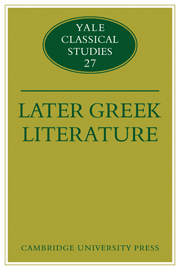Book contents
- Frontmatter
- Contents
- Introduction
- Theme, structure and narrative in Chariton
- The importance of sophists
- Lucian: a sophist's sophist
- The mendacity of Kalasiris and the narrative strategy of Heliodoros' Aithiopika
- The Emperor Julian on his predecessors
- Greek translations of Latin literature in the fourth century A.D.
- The empress and the poet: paganism and politics at the court of Theodosius II
- Pastiche, pleasantry, prudish eroticism: the letters of ‘Aristaenetus’
- The date and purpose of the Philopatris
Theme, structure and narrative in Chariton
Published online by Cambridge University Press: 06 December 2010
- Frontmatter
- Contents
- Introduction
- Theme, structure and narrative in Chariton
- The importance of sophists
- Lucian: a sophist's sophist
- The mendacity of Kalasiris and the narrative strategy of Heliodoros' Aithiopika
- The Emperor Julian on his predecessors
- Greek translations of Latin literature in the fourth century A.D.
- The empress and the poet: paganism and politics at the court of Theodosius II
- Pastiche, pleasantry, prudish eroticism: the letters of ‘Aristaenetus’
- The date and purpose of the Philopatris
Summary
A hundred years ago Chariton's romance Chaereas and Callirhoe seemed a poor thing. It seemed so, certainly, to Rohde, who found plot and characters tame, and did not veil his contempt for the sentimentality of the story, for its unheroic and passive hero and heroine, for the cheapness of its general effect; at the same time he did grant that there was something not unpleasing about its simplicity. Two decades later, papyrological discoveries began to be made which were to lead, if not to a revolution in our estimation of the literary form of the romance, at any rate to such a reversal in our dating of the extant texts as enabled the form to be seen for the first time in a comprehensible literary context and line of development. Chariton profited particularly: from Rohde's date of around a.d. 500 he was brought forward perhaps 400 years – nowadays some would put him a hundred years, or even two hundred, earlier than that; and there is general though not universal agreement that his is the earliest of the extant romance texts. Furthermore, the fact that several papyri of Chariton were found suggests that his story was popular. This advance in knowledge enabled Ben Edwin Perry, fifty years ago, to make of Chariton's story the basis of an already fairly well-developed theory of the origins of the form romance and its place in cultural history, a theory fully set out in 1967 in his magnum opus The Ancient Romances.
- Type
- Chapter
- Information
- Later Greek Literature , pp. 1 - 28Publisher: Cambridge University PressPrint publication year: 1982
- 2
- Cited by



